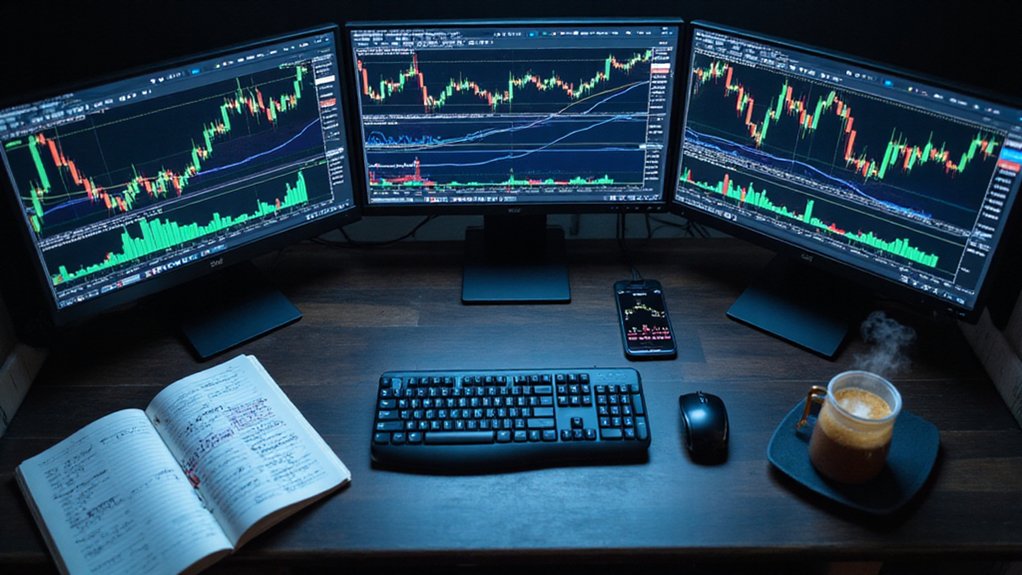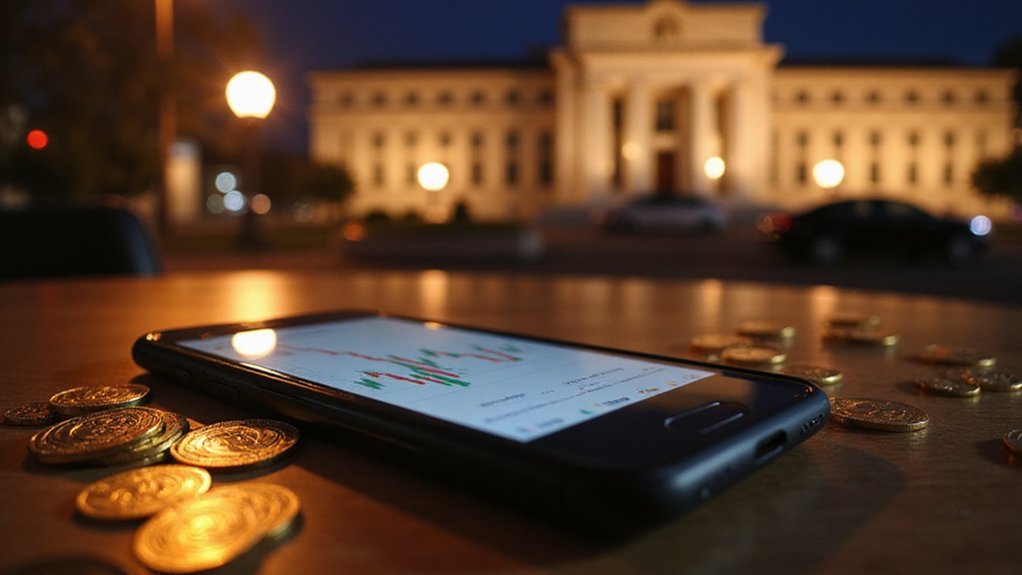TradingView dominates cryptocurrency charting with sophisticated analytical capabilities that transform chaotic digital asset volatility into comprehensible patterns. The platform tracks nearly 4,000 cryptocurrencies across multiple exchanges, offering 400+ indicators, 16 simultaneous chart views, and up to 1,000 custom alerts that eliminate the masochistic tendency to stare at screens indefinitely. Social trading features enable copying successful strategies (however one defines “successful” in crypto’s theatrical landscape), while Pine Script customization satisfies those who find standard tools insufficiently esoteric—though mastering its full potential requires considerably more exploration.

Why do cryptocurrency traders, armed with nothing more than pattern recognition and an unwavering belief in the predictive power of moving averages, consistently flock to TradingView as their charting platform of choice? The answer lies in the platform’s extensive arsenal of analytical tools specifically tailored for the perpetually volatile world of digital assets.
TradingView’s charting capabilities represent the pinnacle of technical analysis sophistication, offering 16 simultaneous chart views per tab alongside over 15 chart types—including the ubiquitous candlestick formations that crypto enthusiasts interpret with near-religious fervor. The platform’s library of 400+ built-in indicators, supplemented by 100,000+ community-created tools, provides traders with enough analytical firepower to dissect every conceivable market movement (whether such dissection yields profitable insights remains, naturally, a separate question entirely).
The platform tracks approximately 3,999 cryptocurrencies, delivering real-time data from multiple exchanges including Binance, Coinbase, and Kraken. This extensive coverage allows traders to compare prices across venues—a particularly valuable feature given crypto’s notorious propensity for price discrepancies that can make arbitrage opportunities appear and vanish faster than a bear market portfolio. Whether focusing on established options like Bitcoin or Ethereum or exploring newer altcoins, TradingView provides comprehensive market coverage for informed decision-making. Crypto payments are accepted for annual plans only, processed through Coinbase’s secure infrastructure.
TradingView’s alert system supports up to 1,000 custom notifications per user, enabling traders to monitor price levels, indicator conditions, and technical patterns without maintaining constant vigilance over their screens. These alerts integrate directly with brokers and exchanges, facilitating immediate order execution when predetermined conditions materialize.
The platform’s social trading component creates a bustling community where traders share analyses, strategies, and market commentary. Copy trading functionality allows users to automatically replicate the trades of purportedly successful traders—though the definition of “successful” in crypto markets often requires considerable interpretation. For additional guidance, the comprehensive Help Center Resources provide detailed explanations of indicators, strategies, and trading tools alongside frequently asked questions.
Perhaps most impressively, TradingView’s Pine Script language enables custom indicator development, while robust backtesting tools allow strategy validation against historical data. Multiple subscription tiers accommodate different needs, from casual chart observers to professional traders requiring 200 parallel chart connections and extensive historical data access.
For cryptocurrency traders seeking extensive analytical capabilities, TradingView delivers a remarkably complete platform that transforms market chaos into organized, actionable intelligence—assuming, of course, that markets truly reward such analytical precision.
Frequently Asked Questions
Can I Execute Trades Directly From Tradingview Charts Without Using External Exchanges?
No, traders cannot execute trades directly from TradingView charts without external exchanges.
TradingView functions purely as a sophisticated front-end interface—essentially a beautifully designed middleman—that requires integration with partner exchanges like HTX, Coinbase, or Bitget to actually execute orders.
The platform transmits trade instructions to these external exchanges, which handle the mundane realities of order execution, asset custody, and liquidity provision that make trading possible.
Does Tradingview Offer Real-Time Price Alerts for All Cryptocurrency Pairs?
TradingView’s real-time alert coverage across cryptocurrency pairs remains frustratingly inconsistent—a reality that depends entirely on exchange partnerships and data feed arrangements.
While major pairs like BTC/USD typically offer genuine real-time functionality, countless altcoin combinations rely on delayed data, rendering alerts virtually useless for fast-moving crypto markets.
Users must verify each symbol’s data source individually, as non-real-time alerts won’t trigger with the precision serious traders demand for volatile digital assets.
Is Tradingview’s Mobile App Functionality Identical to the Desktop Version for Crypto?
TradingView’s mobile app achieves remarkable feature parity with desktop for crypto trading, maintaining synced watchlists, layouts, and thorough market data access.
However, claiming identical functionality would be disingenuous—mobile inherently lacks multi-monitor support, extensive workspace customization, and simultaneous multi-chart analysis capabilities that desktop traders consider essential.
The mobile experience prioritizes portability and touch optimization over the desktop’s spacious, multi-tabbed environment designed for serious analytical work.
What’s the Difference Between Tradingview’s Free and Paid Plans for Crypto Traders?
TradingView’s free plan restricts crypto traders to one chart, three indicators, and a single alert—hardly sufficient for serious analysis.
Paid plans progressively grant access to multiple charts (up to eight), dozens of indicators, hundreds of alerts, and mercifully remove advertisements.
Premium subscribers gain Pine Script access, extended trading hours, and priority support for $240 monthly.
The upgrade becomes essential when complexity demands exceed basic charting capabilities.
Can I Backtest Automated Trading Strategies on Tradingview Using Historical Crypto Data?
Yes, TradingView enables thorough backtesting of automated crypto strategies through Pine Script coding and the Bar Replay feature.
Traders can simulate strategies across extensive historical data for major crypto pairs, analyzing performance metrics like win rates and profit/loss ratios.
The platform supports iterative parameter optimization, though results remain constrained by data quality and the inherent limitation that past performance—however meticulously analyzed—offers no guarantees for future market conditions.









